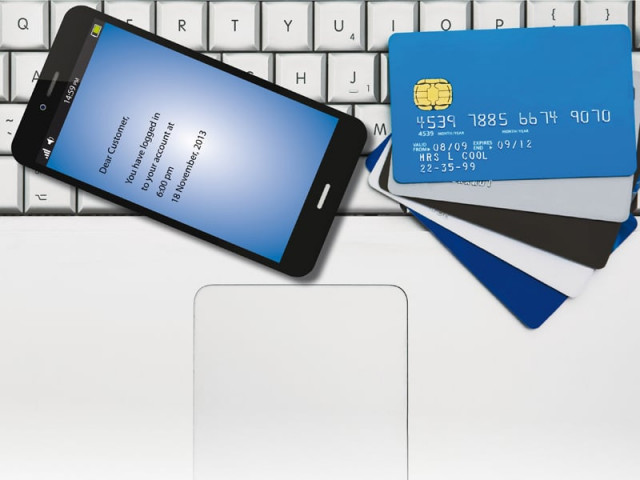Changing trends: Technological developments in the banking sector
Online banking, ATMs, debit cards increasingly contribute to the bottom line.

With branchless banking, MNOs have become players in the financial services arena as they tap into the unbanked population and remittance market. DESIGN: MUNIRA ABBAS
Technological advances are quickly changing the face of the Pakistani banking industry. Alternative channels are growing quickly and represent a sizable portion of banks’ revenue streams as all banks as well as mobile network operators are jumping on the ‘branchless banking’ bandwagon.
As I discussed in the previous piece about shrinking spreads, published on November 4, the business model utilised by commercial banks of collecting deposits and investing in treasury bills is not sustainable. No single additional revenue stream can completely compensate for the declining interest income, so banks will have to aggressively pursue revenue expansion from several diversified streams.
Competition is also expected to intensify in smaller cities as there are many underserved affluent customers in Hyderabad, Multan, Sukkur, etc. Aggressively growing mid-sized banks such as Bank Alfalah and Meezan Bank are looking to expand their branch network to these cities.
Given the intense competition and increasingly price-sensitive customers, price increase for standard banking services, such as cheque book issuance, is unlikely. To generate additional income, banks will have to develop new and innovative products and cross-sell to increase products per customer.
Data analytics
As mobile network operators (MNOs) have done, banks too need to establish business intelligence units which collect and analyse huge volumes of data to drive decision-making throughout the organisation. In coming days, data and analytics will drive growth, drive better risk behaviour and reduce costs. Analytics can help sales and marketing success by:
*Identifying profitability of customer segments and helping the business prioritise relationships/align channels accordingly
*Identifying propensity to buy amongst various customer profiles for more targeted sales efforts and increased success rate
*Identifying cross-sell opportunities to increase the number of products per customer
*Identifying profitable sub-segments to target with tailoured products/services
*Improving risk management through better credit monitoring and effective early warning systems
Alternative channels
At the moment, alternative distribution (online banking, call centres, ATMs, debit cards) is the happening place in retail banking, taking up a major chunk of investment. Banks need to try and create an ecosystem that captures the customer’s entire financial universe, enabling them to ring-fence customers, making them less susceptible to switching over to competition. This can only be done by providing an integrated multichannel offering, intelligently building alliances and attractive yet viable loyalty programmes.
More and more customers see the value of accessing their money 24/7 instead of being constrained by branch banking hours and locations and are signing up for debit cards and internet banking. As a result, alternative channels are contributing an increasingly higher percentage of fee income to the bottom line.
Seamless multichannel offering will reduce the burden on the branch network, cutting costs and improving service quality. Activities like utility bill payments and mobile phone top-ups through internet or call centres save customers a lot of time and effort while simultaneously reducing traffic in the branches. Successful banks will focus on shifting less profitable customers to low-cost channels.
The importance of branches will not decrease as their role will evolve into a sales and service channel with the bulk of transactions happening through remote channels. This could enable them to reduce the number of staff and also potentially increase the coverage area per branch.
Branchless banking
With high mobile penetration and low banking penetration (130 million mobile phone users vs 20 million bank account holders), it is clear branchless banking will have a huge role to play in the future. The number and value of transactions is growing day by day and agent networks are expanding rapidly. What is less clear is what sort of returns can be forecast for the heavy investments being made in setting up the infrastructure.
With branchless banking, MNOs have become players in the financial services arena as they tap into the unbanked population and remittance market. The partnering of banks with a network of retail outlets (agents) can greatly increase outreach and exponentially increase banking customers, which is why a number of banks have entered or will soon enter this market.
However, managing this scale of agents and customers will be very complicated as it is hard to build a network of agents that fulfill the criteria and, unlike the MNOs, banks have no experience in managing agent networks. Success will depend on the ability to develop and manage an extensive network of retail outlets.
The fewer partners the better, otherwise, the complexity will be difficult to handle. According to the McKinsey Quarterly, the experience from across the world is that most efficient operations involve the partnering of one financial institution with one or few distribution networks.
Currently, the bulk of activity is mostly in CNIC-to-CNIC money transfers. For branchless banking to really take off and bring about financial inclusion, however, providers need to move beyond over-the-counter transactions to products that promote a relationship with the customer and offer mobile wallets, savings products with decent returns and direct deposits (salary/pension credits, etc). Banks are moving towards this, but in my opinion it is still some years from fruition.
The writer works on retail banking strategy for a major commercial bank
Published in The Express Tribune, November 18th, 2013.
Like Business on Facebook, follow @TribuneBiz on Twitter to stay informed and join in the conversation.



















COMMENTS
Comments are moderated and generally will be posted if they are on-topic and not abusive.
For more information, please see our Comments FAQ